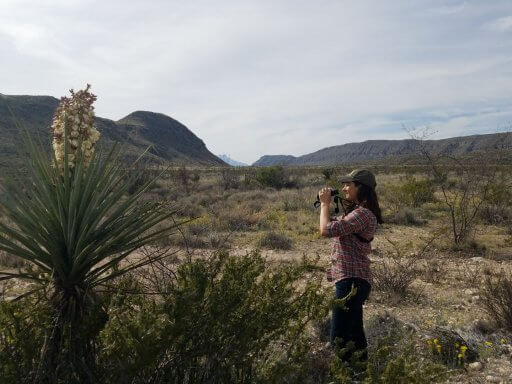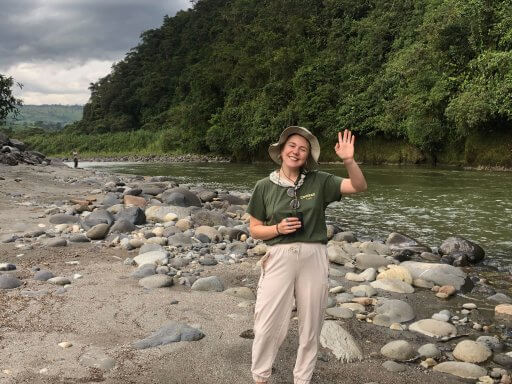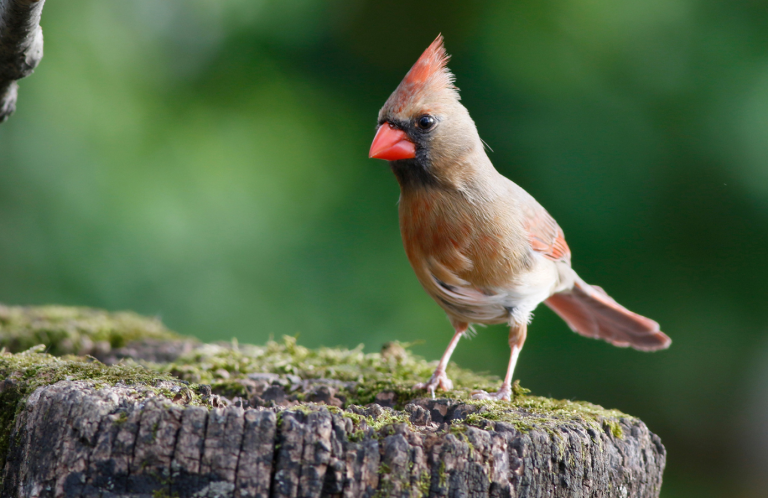Four Women Making Bird Conservation Happen at ABC
This is the third part of a series highlighting the women who work at American Bird Conservancy. Read parts one and two.

Conservation works best when we all get involved. At American Bird Conservancy (ABC), every person, whether they are doing fieldwork or paperwork, plays a part in our ongoing efforts to protect birds and their habitats in the Western Hemisphere. There are a lot of bird conservation heroes working behind the scenes at ABC — and women make up more than half of the ABC Flock! During Women's History Month, we are celebrating the dedication, talents, and expertise of some of the women who make ABC's work happen.
Aimee Roberson, Southwest Regional Director

Aimee Roberson (Choctaw/Chickasaw), ABC's Southwest Regional Director, has extensive experience and deep roots in the worlds of bird and habitat conservation and ecosystem stewardship. Her work supports that of the staff to enhance the quality and connectivity of grassland habitats for species like the Northern Bobwhite and Chestnut-collared Longspur and riparian habitats like the Southwestern Willow Flycatcher and Least Bell's Vireo throughout the Southwest. Aimee is focused on working internally to make sure ABC is a great place to work and fostering strong partnerships with all who care for birds and the ecosystems upon which we all depend.
Aimee's favorite bird, or the bird that got her started on her career path: “Peregrine Falcon — also known as Oskanankubi in Chikashshanompa (Chickasaw language). I also love all kinds of kingfishers.” Read more about Aimee's experience with Oskanankubi and the lessons of Indigenous lifeways she applies to her work to conserve our feathered relatives and our ecosystems.
What makes Aimee proud to be at ABC: “Our commitment to working toward social-ecological wellness, equity, and justice through bird conservation.”
Her advice to budding bird conservationists: “Seek opportunities that allow you to be your whole self, to follow your passions, and to continuously grow while you serve your communities — including your feathered relatives.”
Erica Sánchez Vázquez, Multimedia Producer

If you've attended an ABC webinar in recent years, Erica Sánchez Vázquez was probably working behind the scenes to make it happen! As ABC's Multimedia Producer, Erica manages all aspects of our webinar program, from developing ideas to publishing the recordings. You may also have seen her work in our Bird of the Week emails and on our social media platforms — she is a skilled video editor, too! She typically does a lot of computer work, but each day brings something different, and occasionally she spends time in the field to film ABC's staff and partners at work.
Erica's favorite bird, or the bird that got her started on her career path: “This answer changes a lot, but I'm currently in love with the Rainbow-bearded Thornbill. It's such a cool bird! Before working at ABC, I didn't have the awareness of birds that most of our staff have. I've gained more of it since then and it has been life-changing. I'm still more of a general nature lover, but birds now hold a special place.”
What makes Erica proud to be at ABC: “I admire the breadth of partnerships that we have and the ways we work with our partners to conserve birds and their habitats. There are some very deep, long-lasting relationships that ABC has developed in many places. I am also proud that this work consciously goes beyond birds; so much of it centers people and their well-being as well.”
Her advice to budding bird conservationists: “Keep learning! As a communicator without a science background, I've learned a lot on the go, but it's also helpful to take advantage of learning opportunities out there. Most states have Master Naturalist programs through universities and nonprofits that are low-cost and, of course, there's a range of free online offerings like our webinars!”
Anikó Tótha, Bird Collision Glass Testing Program Coordinator

Up to one billion birds die from collisions with glass each year in the U.S. That is a startling statistic, but it's one that Anikó Tótha, ABC's Bird Collision Glass Testing Program Coordinator, is working to correct. Anikó tests potentially bird-friendly products and works with glass manufacturers to find broad-based solutions to decrease bird collisions. Anikó is usually in the field at tunnel testing sites at key times throughout the year, especially during migration. Testing and research aren't all Anikó does: she shares what she learns with architects, works on legislation, and connects with the public to promote bird-friendly design and eliminate one of the biggest threats to birds.
Anikó's favorite bird, or the bird that got her started on her career path: “I've always been very passionate about nature and birds specifically but my spark bird is the Ruby-crowned Kinglet. They are so fierce, nosy, and energetic. I've been very fortunate throughout my conservation career path and have had many incredible interactions with unbelievably amazing scientists and conservationists who pushed me down this path of doing the work they do. I can name a lot of names, but one of my main mentors is Dr. Christine Sheppard, who also happens to be my boss.”
What makes Anikó proud to be at ABC: “ABC's Glass Collision team is now a team of four people, that I am proud to be a part of. For nine years, it was single-handedly managed by Dr. Christine Sheppard and has made some serious headway in spreading awareness about collisions and finding solutions to decrease collisions. I've been with ABC since May 2021 and was hired specifically to expand our glass testing program. Since building the second tunnel at Foreman's Branch Bird Observatory in Maryland, we have increased our ability to test bird-friendly glass threefold. At this point, we have over 150 commercially available bird-friendly products on ABC's Solutions database.”
Her advice to budding bird conservationists: “Starting your conservation career path can be intimidating. It is a field filled with very committed and driven people. I always recommend volunteering your time anywhere that you are passionate about or any issue that tugs at your heartstrings. Get your foot in the door by making those around you know that you care, that you're hardworking, and that you're dedicated to these conservation concerns. When you make these connections and find your niche and what you want to focus on, you can find the people to help raise you up and help you along your path.”
Elizabeth Vaccaro, Major Gifts Officer

Whether she's working from home with her two cats, or out on the road scoping out new birding hotspots, as ABC's Major Gifts Officer, Elizabeth Vaccaro's days are filled with different projects and programs, making even the most “normal” day interesting. Elizabeth engages the people who make ABC's work possible: our supporters! She shares ABC's conservation information with birders (who play a critical role in conservation work) and collaborates on Justice, Equity, Diversity, and Inclusion (JEDI) initiatives. Elizabeth also represents ABC at conferences and festivals and plans community events and birding outings with the incredible volunteers who make up the ABC Ambassadors.
Elizabeth's favorite bird, or the bird that got her started on her career path: “I have a special place in my heart for backyard birds, and the Northern Flicker is my very favorite. I may or may not have an entire wall of artwork of them in my living room…”
What makes Elizabeth proud to be at ABC: “It's rare to find an organization that prioritizes such meaningful work on the ground and such meaningful care for their staff and partners — ABC is a master of both. I'm proud to be a part of a community of bird lovers and conservationists that put data-backed, science-based conservation work at the forefront of our mission; that value people, culture, and context in our partnerships and programs; that recognize the necessity of equitable and compassionate compensation in a field full of ‘burnout;' and that above all, work for the birds, not for what is trendy.”
Her advice to budding bird conservationists: “My advice would be to continue to follow your passions even when the ‘dream job' still feels out of reach. Volunteer, pick up trash, clean up a habitat, feed your backyard birds, plant native, advocate in your city, bird in your neighborhood, join a community group, start a community group! You can make a difference in the conservation movement regardless of your career. Every single bit counts.”
The women of ABC's Flock show that there are many ways to contribute to bird conservation. While many of them are out in the field working directly on projects from beach cleanups to bird-friendly glass testing, so much happens behind the scenes to support these projects. Behind every bird conservation success story is a team of people who built strong partnerships, researched and collected data, managed grants and finances, and finally, shared the good news with ABC's supporters.
You, too, can contribute to more conservation wins. Take steps toward living a bird-friendly life, use your voice to speak up for birds, and support the work of ABC's Flock.
There is much more to learn about (and from) the women at American Bird Conservancy! This is the third part of a series highlighting the women who work at American Bird Conservancy. Read parts one and two.


















































